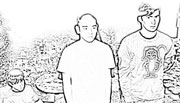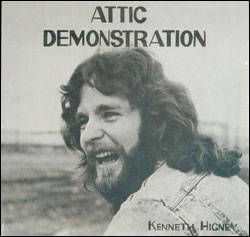IN 1974, FOUR of the weirdest people in the Detroit/Ann Arbor, Michigan, area (guitarist Jim Shaw, drummer/ tape manipulator Mike Kelley, singer and guitarist Cary Loren, and vocalist/violin-player Niagra) formed a garage band and named it after the last great Godzilla movie, Destroy All Monsters. DAM’s early music was a thick, playful caterwaul: Yoko Ono/Nico/Betty Boop fronting a Velvet Underground practice session with Fred Frith and Bob Ostertag sitting in. All Music Guide terms the group “noise deconstructionists” and tells us, “They were an antirock band founded in direct reaction to the pretensions and complacency of 1970s pop music.”
DAM were artists and filmmakers who wanted to make music and didn’t fit in anywhere, so they got together. If this does not sound very remarkable, consider that in ’74 the lines between underground music, film, and art were firmly drawn, and that Kelley and Shaw today rank among the most influential, genre-exploding folks on the international art scene. Now the group is the subject of a unique multimedia exhibition that kicks off CoCA’s 20th anniversary celebration. Curated by Larry Reid, the show begins Friday with a way-rare live DAM performance and runs through August 30.
DAM formed in the dead wake of Detroit’s well-documented and deservedly revered late-’60s cultural implosion. John Sinclair and the White Panther Party (whose motto was “dope, guns, and fucking in the streets”) had fizzled out, while the Stooges, MC5, SRC, Amboy Dukes, et al. had either split or descended into glam-rock shadowplay. There was a definite need for a music that would tear shit up by reintroducing confusion, spontaneity, and that visceral oomph that would later be identified with punk rock.
“The music scene at the time was mostly roots rock and blues—bar band stuff,” Shaw explains on the phone. Enter Destroy All Monsters: Artists Shaw and Kelley had started to make noise on cheap equipment played loud in their shared house/practice space (dubbed “God’s Oasis”). They were also playing art-pranks—putting up flyers for events that never happened.
ACROSS TOWN, LOREN and his model girlfriend Niagra had put up their own posters, announcing parties that did take place. But when people showed up, they unwittingly stumbled onto the set of one of Loren’s underground films. Loren had previously spent a summer with Jack Smith, the great performance artist and filmmaker whose Flaming Creatures had defined the camp aesthetic. Unsurprisingly, Kelley and Shaw befriended the pair. Shaw describes Loren’s art at the time: “He made these beautiful works on paper with arcs of spray paint while lying on the floor; they’d be finished when he passed out from the fumes.” Their music was the logical extension of the MC5’s freakout “Black To Comm” and the Stooges’ free jazz kick, “LA Blues,” flavored with contemporaneous influences such as Terry Riley, Captain Beefheart, and Faust.
There were no bands like ’em in the area at the time; pretty much the only shows they played were when they “hijacked another band’s equipment, and quickly cleared the room,” Shaw recalls. Thurston Moore’s label Ecstatic Peace issued a three-disc collection of their early material in ’95, ensuring that this era of Destroy All Monsters would endure as more than a footnote in that cool, murky era ‘twixt the death of psychedelia and the start of punk, a period that birthed groups like Devo, Pere Ubu, and the Electric Eels in the Midwest and This Heat and the Swell Maps in the UK. Today, the kind of droney, experimental music the group made has a pretty large scene attached to it.
DAM are still best known among record geeks for their later era, after Kelley and Shaw split for California in 1976 to attend grad school at CalArts. Ron Asheton of the Stooges joined the band, along with MC5 bassist Michael Davis, and they sort of hijacked the group. DAM’s songs became simpler and harder-edged. Niagra started seeing Asheton; it wasn’t long before Loren was kicked out of his own band. “I was very depressed when Mike and Jim left—it was chaos, my world fell apart,” Loren says. “I spent some time in a mental ward. When Asheton and Davis came into the band, it was like playing with your teenage heroes, a fantastic dream—high-energy sparks and psychedelic space-music. But it was an overload of ideas and soon blew up.” The band continued without Loren until the mid-’80s, and the original lineup has played a few reunion shows since the mid-’90s.
Kelley and Shaw have been subjects of traveling retrospectives (Kelley in ’93, Shaw in ’99 and again this year) and there are several glossy books of their work to choose from. Kelley has explored every imaginable media, including video, sculpture, performance, writing, and drawing. His charged, psychosexual, humorous work resonates deeply with younger artists. The Los Angeles Times called him “perhaps the most influential American artist of the ’90s.” The insanely talented Shaw creates work that is super-accessible, especially to those with a knowledge of 20th-century subcultures and advertising. He fluidly draws on a startling array of visual languages: Jack Chick tracts, Boy Scout manuals, Tom of Finland drawings, Family Dog psychedelic posters, tabloids like Weekly World News. He is currently, he says, “starting a new religion.”
Niagra’s work is bad-girl comix-influenced stuff that fits well within the lowbrow vernacular aesthetic of Juxtapoz magazine, cosponsors of the CoCA exhibition. Cary Loren is a successful bookstore owner (thebookbeat.com) whose current band Monster Island makes “damaged acid-folk.” Among the books he’s published is a reprint of John Sinclair’s 1965 poetry chapbook, This Is Our Music. Loren is currently assembling a CD collaboration between DAM and his holiness, Sun Ra. “Well it’s not a true collaboration,” Loren explains. “I put together archival spoken tracks by Sun Ra over DAM music; it’s a trippy piece called Message From Space.”
THE CENTERPIECE OF the CoCA exhibit is four huge 12- by 20-feet banners, one-of-a-kind works Kelley and Shaw made together that depict Detroit pop and underground culture icons from the late ’60s and early ’70s. Niagra is unable to perform, but her art is on view. There will be continuous showings of Loren’s films and a re-creation of Shaw and Kelley’s old crash pad, plus photos, flyers, period artwork—the show is a shrine to a band many obscurantists haven’t even heard. The exhibit almost seems like a prank in and of itself. Shaw, Kelley, and Loren will speak at a panel, emphatically titled “The Monsters’ Mash: Rust Belt Noise, Thrift Store Aesthetics, and the Globalization of Detroit Pop Culture,” on Sunday, July 16 at 4pm. The moderator will be UW professor Paul Remley, who happens to be an old pal of the band; he used to tape ’em back in the day.
And what might a visitor take away from this mixed-media feast? “The importance of place,” Loren offers—a notion which, curiously, has hovered in the Seattle air since that thing underneath the Space Needle opened its doors—”how the areas of Detroit and Ann Arbor have made inroads into the culture. The crossover of culture and revolutionary politics is one of the main themes [of the CoCA exhibition]. We were riffing on the trash of a society at the brink of self-destruction. Music can be developed to change the direction of thought and bring people into positive action and energy. Music should be important and vital and open up a new era of change.”
Destroy All Monsters runs Fri 7/14 through Wed 8/30 at CoCA, 65 Cedar, 729-1980. The “Monstrous Opening Party and Performance” takes place Fri 7/14 at 8pm; $7, $5 members.








